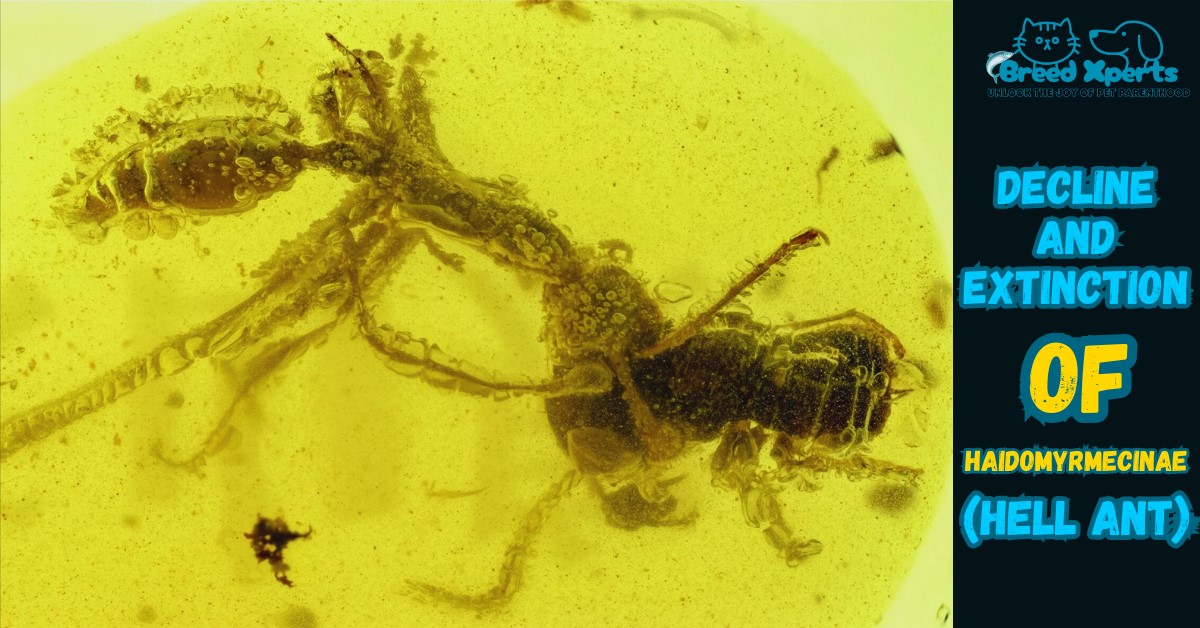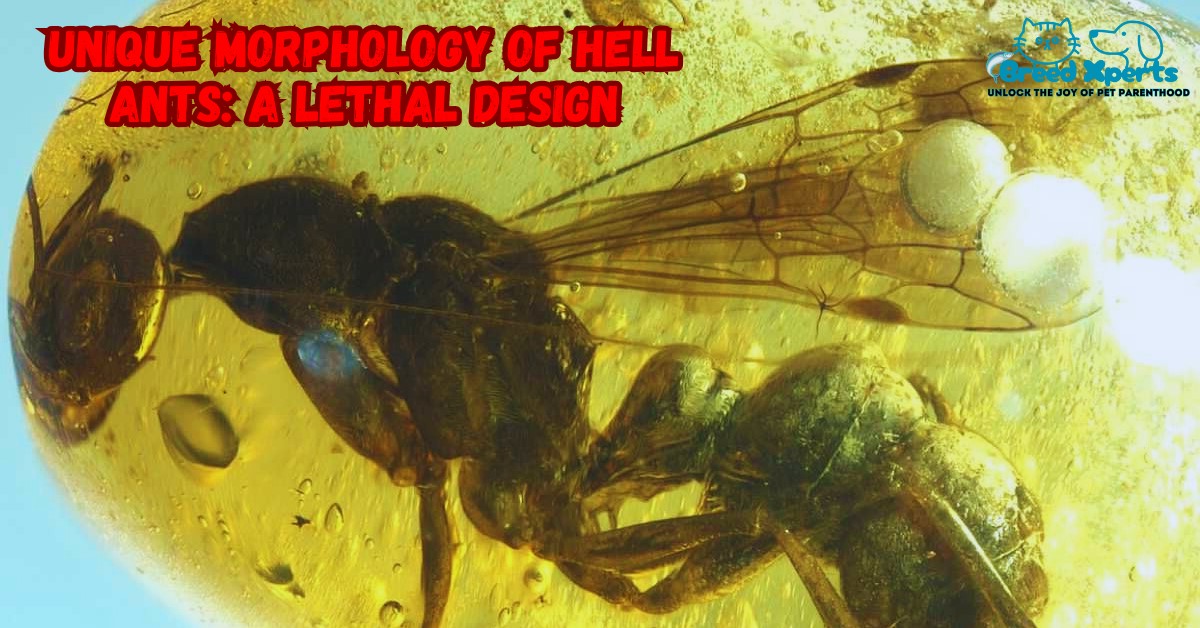Haidomyrmecinae (Hell Ants): 113-Million Year Old ‘Hell Ant’ Fossil Discovered That Lived Alongside Dinosaurs
One of the “hell ants” was recently found, and it existed at the same time as the dinosaurs. The ant was about 113 million years old and existed during the period when the dinosaurs dominated Earth and co-existed with them. The researchers say the fossil is the oldest to be found. The research was conducted and published in the Current Biology journal.
This specific ant, Haidomyrmecinae and popularly a “Hell Ant,” was discovered in Brazil. Its skull was intact inside a rock class labeled as limestone. It is a member of the Haidomyrmecinae family, a family of extinct ants that existed during the Cretaceous period, 45 to 66 million years ago. These ants were far different from ants today. They possessed tremendous, specially built jaws that were curved like blades. Scientists assume that the jaws served to seize and capture prey.
Anderson Leppeko, a Brazilian museum scientist, found the skull last September. He was astonished to notice something peculiar stuck on the head of the ant. Hell ants previously found were typically fossilized in amber (tree resin), but this one was fossilized in rock. This finding confirms that hell ants used to be widespread throughout the world. Today, ants inhabit nearly all corners of our world—except in Antarctica. Scientists have uncovered that ants began to exist approximately 145 million years ago, at the tail end of the Jurassic and Cretaceous periods. Following the extinction of dinosaurs and other various species, ants became one of the most controlling insects on planet Earth.
The experts opine that this new find is very important as it assists us in improving our knowledge of ant evolution. The finding of this fossilized skull has expanded our knowledge of ant past by almost 10 million years. Scientists used 3D imaging technology to scan the fossil and discovered that it has similar features to ant skulls already discovered in Burmese amber. This study is a breakthrough in ant studies and could be the stepping stone to more groundbreaking findings about their past in the far future.

Key Traits:
Group: Extinct Insect Subfamily (Haidomyrmecinae – Family: Formicidae)
Scientific Name: Haidomyrmecinae
Period: Cretaceous Period (approx. 113 to 66 million years ago)
Fossil Locations: Found in amber (Myanmar) and limestone rock (Brazil)
Size: Small to Medium (Typically 5–10 mm in length)
Weight: Lightweight (Exact estimates vary; like modern ants, only a few milligrams)
Life Span: Unknown (likely similar to modern ants: weeks to months depending on caste)
Personality/Temperament: Predatory, Aggressive, Highly Specialized
Energy Level: High (Active hunters with unique ambush techniques)
Social Structure: Eusocial (lived in colonies with hierarchy – queen, workers, etc.)
Unique Features: Vertical, trap-like mandibles; horn-like projections from the head
Coat/Exoskeleton: Hardened chitin exoskeleton
Color: Likely dark brown to reddish (based on fossilized amber specimens)
Diet: Carnivorous (preyed on soft-bodied arthropods or small insects)
Extinction Status: Extinct (~66 million years ago)
Notable Facts: First known ants to use trap-jaw mechanisms; uniquely adapted head morphology.
📌 Did You Know?
- Hell Ants had vertically closing, scythe-like jaws that lacked any equivalent found in modern-day ants.
- The horns and the jaws worked in tandem to snatch prey — a “biological bear trap” from dinosaur times.
- They are often found buried in amber and give scientists an extraordinary window on ancient worlds.
Unique Morphology of Hell Ants: A Lethal Design
What makes Haidomyrmecinae so different from modern ants, and really from any insect alive today, is their distinctive mandible structure. Unlike modern ants, with their horizontal, pincer-like jaws, Hell Ants featured mandibles that moved vertically. These jaws worked like a guillotine, snapping up to impale prey against a horn-like projection that protruded from the head.
This system was not only bizarre—it was mercilessly efficient. In addition to elongated sensory bristles and a reinforced head horn, these changes point towards a specialized hunting existence. The mandibles were not only supple but also supported by muscular developments which allowed them to crush shut with remarkable speed and force, snagging unsuspecting arthropods.
Taxonomy and Species Diversity within Haidomyrmecinae
The subfamily Haidomyrmecinae is categorized under the extinct family Sphecomyrminae, which is frequently viewed as basal or primitive ants. Various genera and species have been identified, including:
- Haidomyrmex scimitarus
- Haidomyrmodes mammuthus
- Ceratomyrmex ellenbergeri
- Linguamyrmex vladi
Each of these species exhibits somewhat different adaptations, pointing to ecological diversity and potential for multiple predatory tactics. For example, Ceratomyrmex ellenbergeri shows the most conspicuous horn structure and is believed to have fed on soft-bodied invertebrates, effectively ensnaring them between its mandibles and horn.
Amber Fossils: Windows into the Cretaceous Ecosystem
The Burmese amber deposits that harbor most of the Haidomyrmecinae specimens are of mid-Cretaceous origin (approximately 99 million years ago). The deposits have an uncommon level of detail, recording as much as the microstructures of the exoskeleton to the trapped prey in the mandibles of the ants.
A particularly well-known specimen of Ceratomyrmex vladi was discovered in the process of an attack, with mandibles clamped upon a nymph of another insect genus—demonstrating unequivocal evidence of how these fossil ants hunted. These fossils play a crucial role in simulating ancient food webs and understanding the evolutionary history of eusociality in early ant colonies.
Ecological Role and Hunting Strategy
Contrary to modern ants that generally rely on social swarming and pheromones, Haidomyrmecinae appears to have been mostly solitary or semisocial with a strong emphasis on ambush predation. Their body form suggests a hunting technique that involves the combination of stillness and rapidity—quietly waiting for the ideal moment to strike with deadly precision.
Their habitats likely contained dense forest litter and decaying wood, upon which soft-bodied insects like larvae and early instars were abundant. From their jaw and head structure, it is likely Hell Ants did not chew or transport large prey, instead adopting enzymatic digestion or a liquid diet, similar to modern trap-jaw ants.
Comparison with Modern Ants: Evolutionary Significance
The contrast between Haidomyrmecinae and modern ants is extreme. Modern ant mandibles are articulated laterally, and most use them for building, object movement, and defense, along with catching prey. Haidomyrmecinae, however, possessed an incredibly specialized predatory mechanism, implying an evolutionary cul-de-sac rather than a precursor to modern mandible function.
Nonetheless, examining Hell Ants offers essential insights into the diverse evolutionary experiments in morphology and behavior observed in ants. It implies that in the initial spread of ants, considerable ecological experimentation occurred, much of which lacks modern equivalents.

Decline and Extinction
The extinction of Haidomyrmecinae is believed to have occurred during the time around the end of the Cretaceous period, in correlation with mass extinctions potentially initiated by the Chicxulub asteroid impact and related environmental upheavals. Their unique niche specialization may have made them vulnerable to ecological perturbations, and the appearance of more socially complex ant species with generalist tendencies may have competed better against them in the rapidly changing Paleogene ecosystems.
Scientific Importance and Ongoing Research
The discovery of Haidomyrmecinae has revolutionized our understanding of the evolution of ants. These belonged to a previously unknown ecological group, enlightening us regarding evolutionary pathways not taken. Their fossils are the center of paleontology research, often highlighted in prominent journals and international exhibitions.
Recent progress in CT scanning and 3D reconstruction has enabled researchers to simulate the kinematics of ant jaws, providing a greater understanding of how these ants may have moved and fed. Current research is revealing new specimens, some featuring preserved gut contents or specific behavioral postures, enhancing the scientific story of this extinct lineage.
Conclusion: The Legacy of the Hell Ants
Although it went extinct long ago, Haidomyrmecinae still signifies nature’s infinite capacity for imagination. With their strange morphology, sophisticated predatory behavior, and cryptic evolutionary history, Hell Ants are perhaps the most captivating prehistoric insects ever discovered. They prompt us to rethink our perception of being an ant and remind us that the evolutionary journey of life is abundant with trials in shape and purpose, many of which disappeared without a sign, except, in this instance, beautifully trapped in amber.
FAQ:
Why are they called hell ants?
Nick-named ‘hell ants’ because of their strange and rather spooky headgear, they have scythe-like mouthparts – or mandibles – that look like tusks curving upward, and a ‘horn’ on the head. So far, the hell ants were estimated to be 100 million years old.
How did hell ants go extinct?
The hell ant lineage, with their distinctive predatory characteristics, is thought to have gone extinct along with several other very ancient ant lineages with ecological changes during the Cretaceous–Paleogene extinction 65 million years ago.
How big were hell ants?
about a centimeter and a half long
This bug was one of the ant subspecies during the Cretaceous age, when T. rexes and Velociraptors lived on Earth. The largest hell ants were approximately a centimeter and a half long, a difference that isn’t particularly big compared to some modern ants. What makes hell ants interesting is their bold headgear.
Why are ants sacred in Islam?
As stated in the 1993 edition of the Encyclopaedia of Islam, from ancient times, ants have evoked admiration because. Of the keen effort they make in providing their 27th chapter (surah) of the Qur’an with 93 verses (ayat), with food, and because of the admirable organization of their societies.
Why are fire ants so evil?
Why are fire ants so aggressive? Fire ants possess a natural combativeness, particularly when they are defending their nest. This natural behavior serves to defend their nest and the queen. They mobilize and strike the danger immediately when threatened, guaranteeing the survival of their colony.
What is the biggest ant in the world?
Dinoponera hosts some of the world’s largest ant species, with Dinoponera gigantea workers being female, measuring 3–4 cm (1.2–1.6 in) long.
Why did the hell pig go extinct?
The extinction of the entelodonts around 16 million years ago may have resulted from competition with other new predators among mammals such as bear dogs, along with alterations in food and environments.
Do big ants feel pain?
Insects do not have a visual cortex, for example, but they can see. As such, it would be possible that insects could also experience pain, but supported through different neural routes than mammals (e.g., multiple realizability and related theories: Chittka et al., 2012; Mallatt and Feinberg, 2021).
How big is 1000000 ants?
One million ants would have a volume of approximately 2.5 liters. The volume of the average adult human is 64 liters. Therefore, it would take 25.6 million ants to match one human.
How big are vampire ants?
4.5–6 mm
A reddish-brown ant, generally 4.5–6 mm (0.18–0.24 in).







